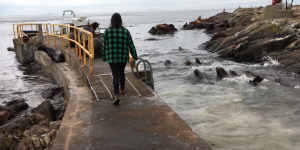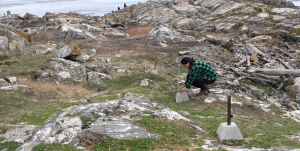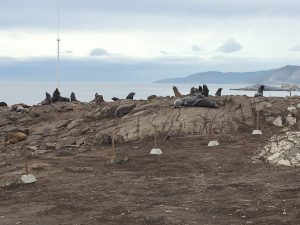Today, Guy Ouradou from Pearson College drove me out to Race Rocks Ecological reserve with David Obura, Pearson College alumni from Kenya year 10. The main change since I was there last was the predominance of California sea lions over most of the island. Northern sealions occupied a small portion of rock near the docks and the isthmus below the light tower. Each year the college has to put up an electric fence to prevent the sealions from invading the centre of the island which can result in damage to conduits, and facilities.
A new fence system is being installed this year, which has so far proven to be very effective. Another aspect of the sealions being on the centre part of the island is that they have been damaging the structure of the rocks arranged in the areas of the aboriginal burial cairns. The big change in sealion distribution is that previously they have concentrated on West Race Rocks, North Race Rocks and the south Islands off the tower. This year there are none out on those islands and they are all on the main island.
I also was able to observe the equipment installed by Oceans Network Canada for CODAR. Hopefully we can get a connection to the output of the data obtained from this equipment when we neet with Kevin Bartlett from Ocean Networks Canada next week on Sept 28.
Earlier this year, Lester Pearson College upgraded the solar batteries which have served for the past 11 years. New inverters were also installed.
- Storage batteries
- New control panels and inverters for the Solar panels
- New storage batteries
 Leaving the island we have to deal with a dock full of sealions which have returned since our arrival.
Leaving the island we have to deal with a dock full of sealions which have returned since our arrival.





